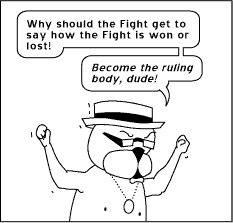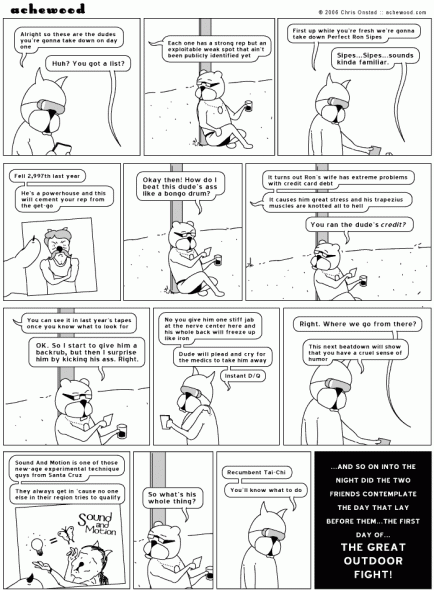The Great Outdoor Fight is one of the ten best works of American fiction of the first decade of the 21st Century. I’m not exaggerating when I say that. I’ll defend that claim against all comers.
I alluded earlier to Onstad’s ability to introduce a fictional pop culture artifact and convince you that it’s real. When I first started in on the Great Outdoor Fight storyline, I was half convinced it was an actual event. Doesn’t it sound plausible? Three thousand men piling into a three acre field somewhere outside Bakersfield to wail on each other. It’s not a grand melee from the age of chivalry. It’s a barroom brawl with refreshment tents outside. If any country could produce a weird, brutal display like that, America could.
Once he’s invented the concept, Onstad piles on additional bits of trivia, building a world in miniature. He does this through Roast Beef, who addresses Ray’s ignorance (and ours) with his typically monotone exposition.
And all this before the fight itself starts.
“The Great Outdoor Fight” contains every element of a classic American story in beautiful excess. It’s about violence and masculinity and pride. It’s about the rituals that surround a piece of culture, from the ancient traditions to modern accoutrements. It’s about a man’s search for his father and what it means to be a friend. But most importantly, it’s about shaking an institution from the ground up, in what is easily my favorite line from Achewood and the truest set of words to live by:

If you’ve read it, nothing more needs to be said; if you haven’t, nothing more should be. Start at the beginning and I’ll meet you back here.
THE END! NO MORAL
I know it’s cliche to talk about anything that happened after the World Trade Center attacks as a response to the World Trade Center attacks. And I promise not to do it for at least six weeks after this. But no one starts a webcomic one month after an unprecedented terrorist attack on American soil without at least thinking about the tragedy.
In the wake of the death, destruction and suffering of the Twin Towers’ collapse came the notion that “irony is dead.” Time Magazine was the first to spear irony’s corpse, declaring that:
In the age of irony, even the most serious things were not to be taken seriously. Movies featuring characters who “see dead people” or TV hosts who talk to the “other side” suggested that death was not to be seen as real. If one doubted its reality before last week, that is unlikely to happen again. Which brings us to the more amorphous zones of reality, such as grief and common sorrow. When the white dust settles, and the bereaved are alone in their houses, there will be nothing but grief around them, and nothing is more real than that. In short, people may at last be ready to say what they wholeheartedly believe. The kindness of people toward others in distress is real. There is nothing to see through in that. Honor and fair play? Real. And the preciousness of ordinary living is real as well–all to be taken seriously, perhaps, in a new and chastened time. The greatness of the country: real. The anger: real. The pain: too real.
Time (if not Time) has thankfully proven Roger Rosenblatt wrong (see: Arrested Development, It’s Always Sunny in Philadelphia, The Daily Show, 30 Rock, The Office, Old School, etc). But in those first few weeks, when coverage of the attack was inescapable, you could very well believe it.
Onstad’s response (if it was meant to address this view) was to hop over irony into pure absurdity. His debut strip defied any attempt at the classic three-line comic strip style.
Yes, drum machines can be confounding. Why is Philippe standing on the instructions for the drum machine? No reason given. Five-year-olds just do odd things sometimes. Why not get him to move? Maybe because the simple pleasure a five-year-old gets from standing on an arbitrary thing is worth more than finding out how to play with our complex electronic toy right this second. Maybe because we get more satisfaction out of positioning ourselves in relation to products – wanting, owning, maintaining, discussing how utterly confounding they are – than we do out of using them as instruments to achieve our goals. Maybe because there’s a Taoist simplicity in saying the thing that you observe. Panel two: “Philippe is standing on it.” Panel three: Philippe is standing on it.
It’s not genius, not yet, anyway. But all of the later elements – Ray’s rise to power, Cartilage Head, dealing with Nice Pete, Roast Beef’s courtship of Molly, death, rebirth and ascension – can all be found there in germ form.
The most common reaction to the September 11th attacks is that the world no longer made sense. What Onstad’s telling us (whether as a reaction to 9/11 or no) is that yes, the world we live in is absurd, but there is yet succor in it.
In his 2009 interview with Vice Magazine, Onstad said, “This is my thing. Achewood is my thing in this life so far. I can’t be lazy about the content. It’s for posterity, my flag for the ages, the tent post I pitched in my 20s and 30s. I’d rather take six years off than have a familiar gag.” Two years later, after the output of new strips trickled to a halt, Onstad announced something to that effect. Doing this saddened his legions of loyal readers, but it in no way diminishes the strength of his prior content. Achewood remains both an example and a challenge of what the webcomic genre – and the sequential art medium, and storytelling in general – can be pushed to in one dude’s hands.
Take ‘er easy, hombre.




Fitting sendoff for a great series (and cookbook!)
Just so you know, most of the in-line links are broken, looping only back to the overthinkingit site.
I’m also really happy to see something referring to 9/11 without being either a blindly patriotic appeal or simple mocking joke. It’s nice thing to see.
Dog damn it. Effing Google Docs (where I draft most of these) insists on putting the wrong side curly quotes whenever I type up an A HREF. Fixing now; thanks for the heads-up.
Anyone who knows how to turn off curly quotes in Google Docs settings, please let me know. I will reward you with spices from Araby, silks from Cathay.
Figured it out. Spices and silks will be left on the curb.
First sentence, link is broken.
I remember the AIBO and the Galaxie 500. If only the AIBO could have moved like the 500.
Fixed, thanks. Everyone should skim that interview, if only as an artifact of modern journalism. Consider that’s the version of the interview that was edited to read as civilly as possible and consider what the actual conversation must have sounded like. And there’s still good stuff there!
This is a far better, more thorough argument for reading Achewood than I’ve been able to come up with on my own. One of my favorite pieces of fiction in any form, and I can hardly get anyone to read it. I’ll be sending this link out all over the place!
Thank you! I struggled to articulate the merits of the strip for a while. I hope it pays off.
minor nitpick — I think it’s set in Northern California. The layout of Achewood is based on Palo Alto.
also, for those people who haven’t read Achewood before, be sure to read the alt-text on the cartoons after 2003 or so (just hover the mouse over the cartoon).
there’s a restaurant on the SF Peninsula that Chris did a lot of his drawing at, and some of the artwork on the walls is posters from old Great Outdoor Fights.
Noted. See update on pg2.
I grew up in the South Bay, went to college in the Inland Empire (Harvey Mudd!), and am now in graduate school in Ohio. I can honestly say there’s not that much difference between the wealthy suburbs in Palo Alto and the wealthy suburbs of the Inland Empire, and by extension the suburbs of the Midwest. Maybe the area around Palo Alto is a little less conservative and a little more yuppie, but I think suburbs everywhere in the United States are pretty homogenous.
I hope most of the world is not thinking of San Francisco when they think of SoCal, because San Francisco is in NorCal (where I’m from). Not that there’s really a whole lot of difference between the two, in the grand scheme of things.